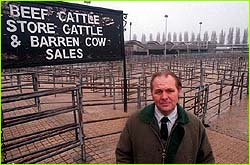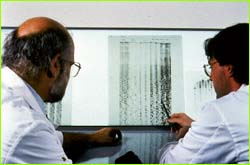|
|
|
|
 |
20/20 Hindsight by Joseph S. Levine On March 20, 1996 the British government announced a potential link between "Mad Cow Disease" (or B.S.E.) and a new variant of Creutzfeldt-Jakob disease (or C.J.D.). The impact on the cattle industry was immediate and profound; the British beef market fell by 30 percent within two days. In the Middle East consumption fell by more than 80 percent. Yet it's possible that if the announcement had been made earlier, at least 20 people could have avoided falling prey to a slow-acting, insidious, and ultimately fatal disease.  Even more frighteningly, it is possible that hundreds, even
thousands, of people who ate British beef products during the
previous decade are also infected. Mass media and critics of
the government demanded to know why more wasn't done to
protect public health.
Even more frighteningly, it is possible that hundreds, even
thousands, of people who ate British beef products during the
previous decade are also infected. Mass media and critics of
the government demanded to know why more wasn't done to
protect public health. Unfortunately, hindsight in science, as in life, is nearly always 20:20, and can be self-righteously omniscient and rational. Foresight in the face of uncertainty, on the other hand, is often myopic, subjective, and fraught with bias. If scientific knowledge could leap predictably and confidently from one paradigm to another, the situation would be less complicated. But in the real world, science often progresses rather more hesitantly and tentatively. The translation of newly emerging scientific findings—with their accompanying uncertainty—into recommendations that have profound effects on individuals, on public health, and on large industries is no simple matter. At what point does slowly accumulating and often incomplete scientific information justify major new public policy initiatives? In any situation, there are inevitably two sides to each issue, and numerous difficult decisions to be made. Should government regulations enforce intensive (read: expensive) precautions to provide the greatest possible protection to the maximum number of people—with no regard to cost? Or should regulatory agencies restrict their actions to more lenient directives that incur minor calculated risks to public health—while keeping corporate profits up and consumer prices down? When policy decisions can protect public health with little or no economic impact, barriers to making such decisions are minimal. But when the first cases of B.S.E. emerged in Britain during the 1980's, the Ministry of Agriculture, Fisheries, and Food (M.A.F.F.) realized that any statements it made concerning the safety of British beef products would profoundly affect an industry that was worth roughly four billion pounds each year (approximately $6,497,000,000) and which employed somewhere in the vicinity of 136,000 people. Did this peculiar new affliction of cows present a real threat to humans? Did it even present a serious threat to cattle herds? No one yet knew for certain what caused B.S.E., or how it was transmitted. In February, 1989, a M.A.F.F. committee headed by Sir Richard Southwood of Oxford University made what seemed at the time to be a reasonable judgment. The committee supposed (although it did not know for certain) that the infectious agent responsible for B.S.E. was the same as the cause of scrapie in sheep. It knew that scrapie had been present in British sheep for at least 200 years without ever crossing over into humans—or any other animal species, for that matter. Based on its interpretation of data available at that time, the commission issued an opinion that it would be "most unlikely that B.S.E. will have any implications for human health." In the committee's judgment, the species barrier between ruminant animals (cud-chewers such as cows, sheep and goats) and humans would protect us from infection. That judgment—along with modest estimates of the number of British cattle likely to be infected over time—proved to be tragically, disastrously wrong. With acute hindsight, recent critics have been quick to condemn M.A.F.F. and its committee as grossly uninformed and/or overly beholden to business interests at the expense of public health. (See, for example, the excellent New Yorker article cited in Resources.) But, for better and for worse, conservative judgments of the sort made by M.A.F.F. in this case are the rule rather than the exception in situations where radical new discoveries are in the offing and new models of living systems are still an elusive, moving target. By curious coincidence, the mid 1980's was also the time when fierce battles were raging in the United States over public health recommendations related to another mysterious new disease. AIDS had appeared and had clearly begun to spread. But its causative agent had not yet been positively identified, and its modes of transmission were still under dispute. Frontline researchers had already convinced themselves that AIDS could be carried in blood and blood products; they were fighting an uphill battle (largely behind closed doors) to convince operators of major blood banks that new, more stringent (and more expensive) precautions were needed to protect the blood supply. There again, a series of conservative decisions proved tragically wrong. Procedures to screen donated and purchased blood were not put in place until it was too late—and thousands of units of HIV-contaminated blood and clotting factor had infected unwitting patients and hemophiliacs. Environmental change and invisible enemies The emergence of new diseases such as HIV and B.S.E. may have been unheard of in recent decades, but it is no longer a surprise to organizations like the World Health Organization and the Centers for Disease Control in Atlanta. Our species has been responsible for extensive environmental change since the dawn  of civilization. That in and of itself is not necessarily a
bad thing. But the change human activity is now causing in
local and global environments, in the way we obtain our food,
and in the ways in which members of our species interact with
one another all expose us to new and previously unexpected
risks from disease-causing organisms. Here's why.
of civilization. That in and of itself is not necessarily a
bad thing. But the change human activity is now causing in
local and global environments, in the way we obtain our food,
and in the ways in which members of our species interact with
one another all expose us to new and previously unexpected
risks from disease-causing organisms. Here's why.We as a species have enough trouble recognizing the effects of our activities on organisms large enough for us to see: whales, redwoods, owls, and the like. Not surprisingly, we (and, until recently, this "we" has meant scientists as well) have long remained oblivious to the effects of our actions on the environments experienced by our invisible enemies: bacteria, viruses, and other parasites. We don't always understand the ways in which those microorganisms interact with us, with the plants and animals we raise for food, and with each other. Unfortunately, that lack of knowledge can prove fatal. Once again, AIDS is an obvious example of how social and environmental change can lead to the emergence and spread of a deadly new disease. In the case of HIV, encroachment of human populations on previously remote African environments, social upheaval and migrations of human populations across Africa, extensive international travel for business and recreation, and changes in sexual behaviors among both heterosexuals and homosexuals around the world have all dramatically changed the "environment" for human diseases—and worked together to unleash the AIDS epidemic. More local versions of the story include such frightening cautionary tales as Ebola Fever which, luckily for the rest of the world, remained localized in a small area of Africa. Other examples waiting in the wings include diseases such as Dengue Fever and Yellow Fever; tropical mosquitoes which carry diseases are slowly moving north into the continental United States and other "temperate" countries as an ecological consequence of steadily rising average temperatures in the Northern Hemisphere. The story of Mad Cow disease provides a fascinating, if frightening, new example of how an apparently innocuous human-caused change in the food chain resulted in the transmission of a new disease to humans. Ever since ruminant animals such as cows and sheep evolved their modern anatomy and physiology, they have lived by eating plants, largely grasses. As these animals evolved, they also co-evolved with their own particular assortment of parasites and diseases, just as humans have. Some parasites whose primary targets are grazing animals (certain forms of sleeping sickness, for example) can infect several different ruminant species as well as humans. Many more parasites are  restricted to a single primary host, and "jump" to new species
very rarely, if at all. Generally, these sorts of
host-parasite relationships remain fairly stable—unless
and until a major environmental or ecological change comes
along.
restricted to a single primary host, and "jump" to new species
very rarely, if at all. Generally, these sorts of
host-parasite relationships remain fairly stable—unless
and until a major environmental or ecological change comes
along. Human societies around the world have recognized this stability, and have responded to it in various ways. Old Testament dietary laws concerning the eating of meat, for example, require (among other things) that animals chew their cud. Carnivores and scavengers were declared "unclean." Cows and sheep remained plant eaters throughout human history—until the advent of certain modern agricultural practices. Not all that long ago, farmers began feeding cows and sheep with dietary supplements containing rendered body parts of other cows and sheep. This dramatic change in the domestic animal food chain effectively turned both sheep and cows into partial carnivores (if not cannibals). While rendered animal-part supplements provided additional protein that encouraged more rapid growth of cows, they also opened a completely new series of doors through which the infectious agent of T.S.E could first cross from sheep into cattle, then sweep through cattle herds with extraordinary speed and efficiency, and finally jump another species barrier into humans. Once again, 20:20 hindsight in this case is trivially easy. The important question is whether or not we have our eyes open for other, new, unexpected, and potentially lethal threats to public health that may be brewing in other parts of our food supply. Joe Levine is a biologist, educator, and science journalist. He is the author of six books and numerous articles on scientific subjects, and the co-author (with Kenneth Miller) of two widely acclaimed biology textbooks for high school and college students. Photos: (1) Reuters/Dave McHugh/Gloucestershire Echo/Archive Photos; (2) Visuals Unlimited/©SIU; (3) Visuals Unlimited/©Walt Anderson. When Science Faces the Unknown | 20/20 Hindsight Food Safety Tips | Do Prions Exist? Teacher's Guide | Resources | Transcript | Brain Eaters Home Editor's Picks | Previous Sites | Join Us/E-mail | TV/Web Schedule About NOVA | Teachers | Site Map | Shop | Jobs | Search | To print PBS Online | NOVA Online | WGBH © | Updated November 2000 |